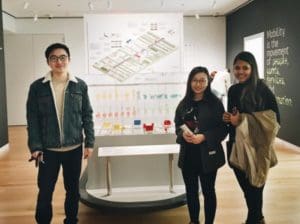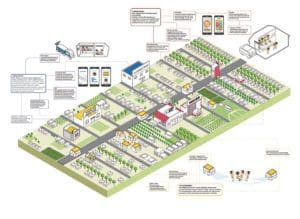Which Way Forward? Equitable Mobility for Detroit in 2030
December 1, 2020The 2030 Detroit Equitable Mobility, a joint project by the College for Creative Studies (CCS), Design Core Detroit, Ford Motor Company and the communications agency GTB has, is on display at the Smithsonian Design Museum as a part of the Road Ahead exhibition.

Detroit’s mobility ecosystem — how citizens get from one place to another — has been a source of concern for decades. In a car-dependent town with an ailing public transportation system, how can all members of the community, regardless of location, socioeconomic status, age or ability, move freely and safely around the city? And how can designers leverage government, education, industry and community resources — not only to ensure equal access for all but also to ensure that a variety of voices have a stake, and a voice, in mobility conversations?
A joint project by the College for Creative Studies (CCS), Design Core Detroit, Ford Motor Company and the communications agency GTB has, since fall 2017, been tackling these questions in the 2030 Detroit Equitable Mobility project. The two project outcomes Scenario Design and Service Design, created by CCS graduate students, were featured at the Cooper Hewitt, Smithsonian Design Museum in the exhibition, The Road Ahead: Reimagining Mobility and at the Detroit Design 139 INCLUSIVE FUTURES EXHIBITION.
The project consists of two phases. Led by CCS Professor and Chair of MFA Integrated Design Maria Luisa Rossi, students in the first phase (MFA Integrated Design and MFA Transportation Design) focused on education, health, employment and socialization among Detroit’s residents to develop three long-term mobility scenarios (potential solutions).
“Placemaking” focused on building a sense of community ownership among Detroit youth. “Entry Point” looked at entrepreneurship training to address the scarcity of entry-level jobs in the city as well as the lack of preparedness among young adults for such jobs. And “Care Exchanging” sought to develop a community health plan to address such health issues as diabetes and obesity among Detroiters and limited access to meaningful healthcare. The purpose was to understand average Detroiters’ circumstances and to arrive at viable solutions to help improve their quality of life.
In the second phase of the project, students from MFA Integrated Design worked with Detroit nonprofit Focus: HOPE, using co-creation sessions to identify community needs and priorities and validate the services.
To create the condition that brings the neighborhood community together, encourages youth to be motivated, and not limiting “innovation” to bare technology, students developed services to support Detroit citizens at a neighborhood scale. They provided a sustainable health care support and preventive nutrition information; a health data collection system that generates nutrition strategy/menu, served by a platform where residents bank their time; help to the learning incubators mobility connection, supporting a future education system and soft skill training; and a service that allows the youngest to seek employment.
The CCS student scenarios appearing in the Road Ahead exhibition at the Smithsonian Design Museum were among 40 projects developed all over the country exploring topics around the future of mobility and the urban environment.
The greatest challenge for many students, throughout all phases of the project, has been to challenge their own assumptions about everyday Detroit life and to align professional design thinking with the way real Detroiters see themselves.
“What are their needs and what are their desires? I think what [students] learned was how to understand and how to empathize with people who are maybe quite different from them,” Rossi told Detroit Driven. “And how to keep their own creativity serving the purpose of creating a good solution for the user’s needs.’
“I think the process was very humbling,” said Shriya Garg, an MFA student in Integrated Design. “My whole approach to design turned a little more sophisticated and very, very, very human centered.”
Detroit Equitable Mobility 2030, Scenario Design

Shriya Garg; Zeping Wang; Kailin Wang; Wei Wang; Maria Luisa Rossi; Jan Moeller; Dong Wu; Fei Xei; Woonghee Chung, Digital
This drawing illustrates three long-term equitable mobility design scenarios – Entry Point, Place-making and Care Exchange – that aim to improve the work prospects, youth retention rates, and health outcomes for under-served Detroit neighborhoods in the future.
Credits: Maria Luisa Rossi with Wei Wang, Kailing Wang, Zeping Wang, Shriya Garg, and Transportation Design students Woonghee Chung, Fei Xei, Dong Wu, and Jan Moeller
Detroit Equitable Mobility 2030, Service Design

Shriya Garg; Zeping Wang; Kailin Wang; Wei Wang; Maria Luisa Rossi, Digital
This drawing presents four service design concepts: Soft skill education (yellow), student outcome (pink), care exchange (green), and health data collection (blue).
Each icon on the model represents a service touch-point, which informs the designer where to enhance the user/provider experience.
Credits: Maria Luisa Rossi with Wei Wang, Kailing Wang, Zeping Wang and Shriya Garg
